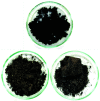Optimization of closed-cycle oil recovery: a non-thermal process for bitumen and extra heavy oil recovery
- PMID: 35480027
- PMCID: PMC9037303
- DOI: 10.1039/d1ra02855c
Optimization of closed-cycle oil recovery: a non-thermal process for bitumen and extra heavy oil recovery
Abstract
Energy from unconventional resources includes bitumen and extra-heavy oil that represent two-thirds of the known resources in the world. Extra-heavy oil and bitumen are currently recovered using thermal processes having a large carbon footprint and significant environmental impacts on water resources. A novel process is proposed: closed-cycle oil recovery (C-COR). C-COR is a greener alternative to provide energy from these unconventional resources with minimal water consumption. C-COR relies on recovering oil solubilized within a single-phase microemulsion, eliminating the need for viscosity reduction to both mobilize heavy oil or to transport it. Proof-of-concept work was conducted using conventional phase behavior experiments with extracted oil and surfactant formulations to develop a surfactant formulation for oil recovery using C-COR. As a part of process development and scale-up, we conducted flow experiments presented in this paper. We learned that a high degree of surfactant adsorption, which negatively impacted the C-COR process, resulted at low pH levels. These findings required modifying traditional static batch tests (phase behavior studies) using actual oil sand instead of the extracted oil. These unorthodox tests revealed that surfactant adsorption caused low oil solubilization and that alkali can be used to reduce adsorption, improving oil solubilization. In addition, unique flow experiments were designed to optimize the delivery and recovery process and are presented in this paper. The unique batch tests and flow experiments were conducted using oil sands from Canada to optimize the process. The proposed optimized approach would employ intermittent flow (soaking) that would result in the fastest recovery of about one-third of the OOIP, followed by continuous injection to recover an additional 10% OOIP, ending with thermal enhancement to recover another 25% OOIP for a total of 61%.
This journal is © The Royal Society of Chemistry.
Conflict of interest statement
There are no conflicts to declare.
Figures











References
-
- IEA, Resources to Reserves 2013 – Oil, Gas and Coal Technologies for the Energy Markets of the Future, OECD Publishing, Paris, 2013, 10.1787/9789264090705-en - DOI
-
- WEC, 2010 Survey of Energy Resources, World Energy Council, 2010, pp. 123–150, downloaded July 17 2020: https://www.worldenergy.org/publications/entry/world-energy-resources-20...
-
- Fassihi M. R. and Kovscek A. R., Low-Energy Processes for Unconventional Oil Recovery, SPE Monograph Series, 2017, vol. 27, ISBN: 978-1-61399-475-7
-
- Banerjee D., Oil Sands, Heavy Oil, & Bitumen: From Recovery to Refinery, PennWell Corporation, Tulsa, US, 2012, ISBN: 978-1-59370-260-1
-
- Butler R. M. Steam-Assisted Gravity Drainage: Concept, Development, Performance and Future. J. Can. Pet. Technol. 1994;33(2):44–50. doi: 10.2118/94-02-05. - DOI
LinkOut - more resources
Full Text Sources
Research Materials

